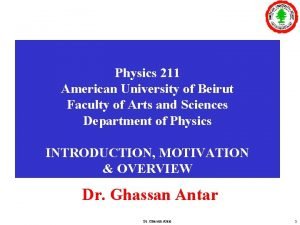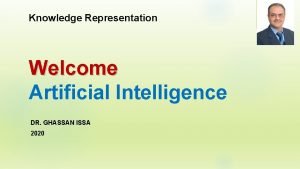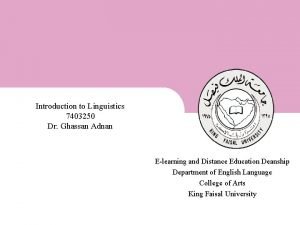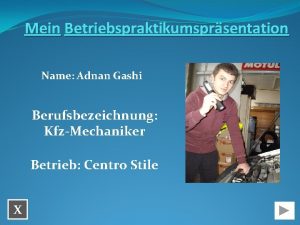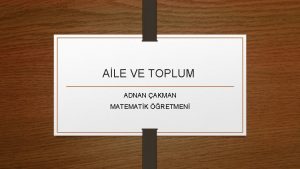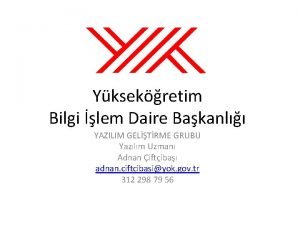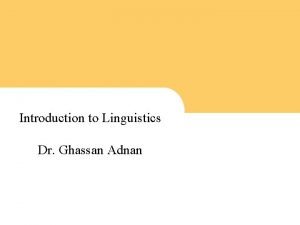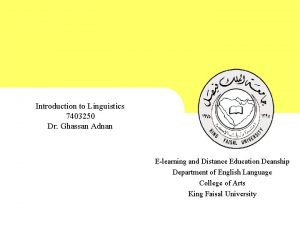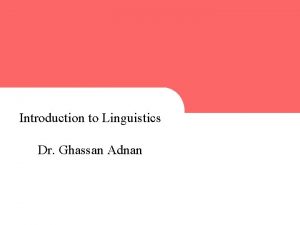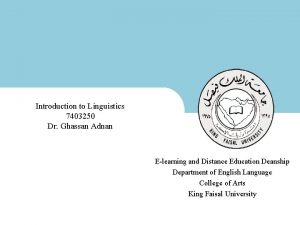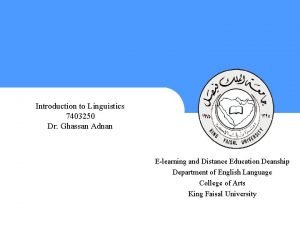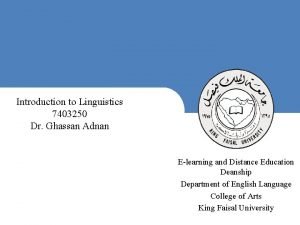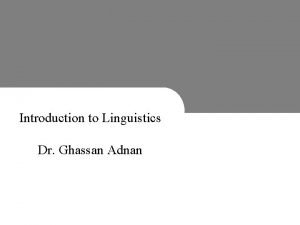Introduction to Linguistics Dr Ghassan Adnan 1 1









- Slides: 9

Introduction to Linguistics Dr. Ghassan Adnan 1 1

Course Content • • • 1. Animals and human language • Properties of human language • Displacement • Arbitrariness • Productivity • Cultural transmission 2. The sounds of language • Phonetics • Voiced and voiceless sounds • Place of articulation • Bilabials • Labiodentals • Dentals • Alveolars • Velars and Glottals • Charting consonant sounds 2 Manner of articulation Stops Fricatives Affricates Nasals Liquids Glides Vowels Diphthongs

Course Content 3. The sound patterns of language • Phonology • Phonemes • Phones and allophones • Minimal pairs and sets • Syllables • Consonant clusters • Assimilation • Elision 4. Word formation: • Etymology • Coinage • Borrowing • Compounding • Blending • Clipping • Backformation • Conversion • Acronyms • Derivation • Prefixes and suffixes 3

Course Content 5. Morphology • Morphemes • Free and bound morphemes • Lexical and functional morphemes • Derivational and inflectional morphemes • Morphological description • Morphs and allomorphs 6. Grammar • Traditional grammar • The parts of speech • Nouns • Articles • Adjectives • Verbs • Adverbs • Prepositions • Pronouns • Conjunctions • Agreement • Traditional analysis • The prescriptive approach 4

Course Content 7. Syntax • Deep and surface structure • Structural ambiguity • Recursion • Tree diagrams • Symbols used in syntactic analysis • Lexical rules • Movement rules 5 8. Semantics • Meaning • Semantic features • Semantic roles • Agent and theme • Lexical relations • Synonymy • Antonymy • Hyponymy • Prototypes • Homophones and homonyms • Polysemy • Word play • Metonymy

Course Content 9. Pragmatics • Meaning • Context • Deixis • Reference • Inference • Anaphora • Presupposition • Speech acts • Direct and indirect speech acts • Politeness • Negative and positive face 10. Discourse analysis • Meaning • Cohesion • Coherence • Speech events • Conversation analysis • Co-operative principle: • Hedges • implicatures • Background Knowledge • Schemas and scripts 6

Course Content 11. First language acquisition • Acquisition • Input • The acquisition schedule • Cooing and babbling • The one-word stage • The two-word stage • Telegraphic speech • Developing morphology • Developing syntax • Forming questions • Forming negatives 12. Second language learning • The Audio-lingual method • Foreign language (EFL) • Second language (ESL) • Acquisition • Learning • Focus on method • The Grammar-translation method • Communicative approaches: 7

Course Content 13. Gestures • Meaning • Types of gestures • Iconics • Deictics • Beats • Types of sign languages • Alternate sign languages • Primary sign languages • The structure of signs • Shape and orientation • Location and movement • Primes, faces and finger-spelling 8


